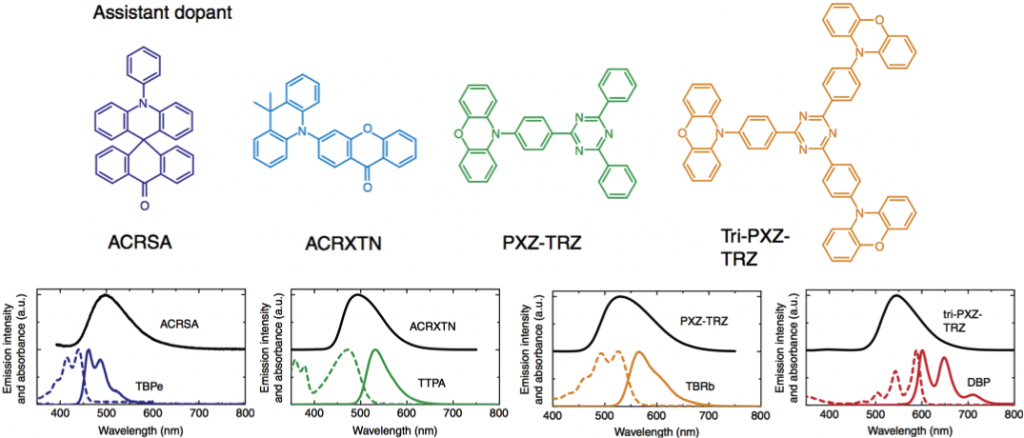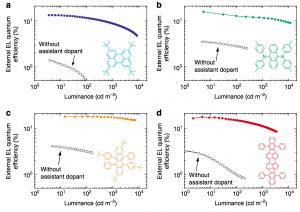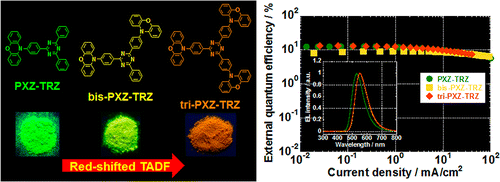H, Nakanotani .; T, Higuchi.; T, Furukawa.; K, Masui.; K, Morimoto.; M, Numata.; H, Tanaka.; Y, Sagara.; T, Yasuda.; C, Adachi. Nature commu., 2014, 136, 9256–9259.
DOI: 10.1038/ncomms5016
Fluorescence-based organic light-emitting diodes have continued to attract interest because of their long operational lifetimes, high colour purity of electroluminescence and potential to be manufactured at low cost in next-generation full-colour display and lighting applications. In fluorescent molecules, however, the exciton production efficiency is limited to 25% due to the deactivation of triplet excitons. Here we report fluorescence-based organic light-emitting diodes that realize external quantum efficiencies as high as 13.4–18% for blue, green, yellow and red emission, indicating that the exciton production efficiency reached nearly 100%. The high performance is enabled by utilization of thermally activated delayed fluorescence molecules as assistant dopants that permit efficient transfer of all electrically generated singlet and triplet excitons from the assistant dopants to the fluorescent emitters. Organic light-emitting diodes employing this exciton harvesting process provide freedom for the selection of emitters from a wide variety of conventional fluorescent molecules.
As mentioned in the abstract, how to create OLED (organic light-emitting diode) that can smoothly convert electricity into light with high efficiency is very important. Looking at the fundamental equation that describes and limits OLED capabilities as following equation, one will find that the external electroluminescence quantum efficiency (ZEQE) is reflected on four factors.
ηout: The light-out-coupling efficiency. This value is tough to be improved because the light (fluorescence and phosphorescence) from organic molecule is multidirectional and only a limited source of light can be extracted from the surface.
γ: γis called charge balance of injected holes and electrons. With current technology, nearly 100 % efficiency can be attained.
ΦPL: Quantum yield of fluorescence and phosphorescence from organic material. This figure can also be upped to 100% with carefully designing and theoretical calculations.
ηγ: The last terms is named efficiency of radiative exciton production. Easily put, this very term plays the most significant role in determining the total quantum efficiency (ηEQE).
The author of this paper (Adachi group) is famous for having developed delayed fluorescence for organic electroluminescence where the nearly 100 % internal EL quantum efficiencywas realized. In this paper, his group established double-dopant system where full-color emission with 100 % internal EL quantum efficiency was achieved. Detail mechanism and energy diagram are shown below.
(1) The exciton from injected hole and electron are predominantly formed on the local assistant dopants.
(2) Following spin statistics, 75% of all electrons are allocated to triplet and 25 % to singlet state of assistant dopants.
(3) Electrons in the triplet state (75 % of all) are up-converted to single state due to thermal effect. This is possible because the assistant dopants used here are carefully designed to possess narrowed gap between singlet and triplet state.
(4) The electron in the single state of assistant dopants is transferred to that of second dopant, emitting dopant in the host material. The ultimate fluorescence from emitting dopants is observed.
This system has wide utility of photo-luminescence molecules and huge selection of color from blue to red. To illustrate this, the author demonstrated four emitting dopants width appropriate host material and assistant dopants. The structure of assistant dopants, spectrums and other data are summarized in the table below.
With this optimized double dopant system, author and his colleagues fabricated full-color OLEDs for further assessment. Also, the effect of presence of assistant dopants was examined. By comparing external EL quantum efficiency of with and without assistant dopants, it revealed that assistant dopants not only maximize internal EL quantum efficiency but also minimize triplet-triplet annihilation process when dense current are applied.
As a part of supporting data, time-resolved electroluminescence decay experiment and optical excitation experiment were performed regarding to the device with red emission. As shown below, both decayed EL and prompt are well consistent. In addition to this, optical excitation experiment clearly showed that the Electrical excitation had longer fluorescence life time. All these experiments support the mechanism proposed in this paper.
- References
[1] “Highly efficient organic light-emitting diodes from delayed fluorescence ”
Uoyama, H.; Goushi, K.; Shizu, K.; Nomura, H.; Adachi, C. Nature 2012, 492, 234–238. DOI: 10.1038/nature11687
The inherent flexibility afforded by molecular design has accelerated the development of a wide variety of organic semiconductors over the past two decades. In particular, great advances have been made in the development of materials for organic light-emitting diodes (OLEDs), from early devices based on fluorescent molecules1 to those using phosphorescent molecules2, 3. In OLEDs, electrically injected charge carriers recombine to form singlet and triplet excitons in a 1:3 ratio1; the use of phosphorescent metal–organic complexes exploits the normally non-radiative triplet excitons and so enhances the overall electroluminescence efficiency2, 3. Here we report a class of metal-free organic electroluminescent molecules in which the energy gap between the singlet and triplet excited states is minimized by design4, thereby promoting highly efficient spin up-conversion from non-radiative triplet states to radiative singlet states while maintaining high radiative decay rates, of more than 106 decays per second. In other words, these molecules harness both singlet and triplet excitons for light emission through fluorescence decay channels, leading to an intrinsic fluorescence efficiency in excess of 90 per cent and a very high external electroluminescence efficiency, of more than 19 per cent, which is comparable to that achieved in high-efficiency phosphorescence-based OLEDs3.
[2] “Twisted intramolecular charge transfer state for long-wavelength thermally activated delayed fluorescence ”
Tanaka, H.; Shimizu, K.; Nakanotani, H.; C. Adachi. Chem. Mater. 2013, 25, 3766–3771. DOI: 10.1021/cm402428a
Emission wavelength tuning of thermally activated delayed fluorescence from green to orange in solid state films is demonstrated. Emission tuning occurs by stabilization of the intramolecular charge transfer state between a phenoxazine (PXZ) donor unit and 2,4,6-triphenyl-1,3,5-triazine (TRZ) acceptor unit separated by a large twist angle. The emission wavelengths of mono-, bis-, and tri-PXZ-substituted TRZ exhibit a gradual red shift while maintaining a small energy gap between the singlet and triplet excited states. An organic light-emitting diode containing a tri-PXZ-TRZ emitter exhibited a maximum external quantum efficiency of 13.3 ± 0.5% with yellow-orange emission.









